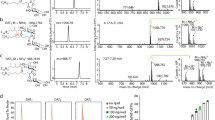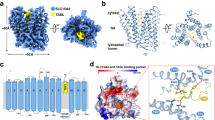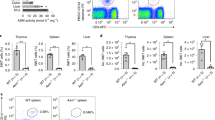Abstract
Lipids from Mycobacterium tuberculosis are presented through CD1 proteins to T lymphocytes in humans, but the accessory molecules required for antigen loading and presentation remain unidentified. Here we show that fibroblasts deficient in sphingolipid activator proteins (SAPs) transfected with CD1b failed to activate lipid-specific T cells. However, the T cell response was restored when fibroblasts were reconstituted with SAP-C but not other SAPs. Lipid antigen and SAP-C colocalized in lysosomal compartments, and liposome assays showed that SAP-C efficiently extracts antigen from membranes. Coprecipitation demonstrated direct molecular interaction between SAP-C and CD1b. We propose a model in which SAP-C exposes lipid antigens from intralysosomal membranes for loading onto CD1b. Thus, SAP-C represents a missing link in antigen presentation of lipids through CD1b to human T cells.
This is a preview of subscription content, access via your institution
Access options
Subscribe to this journal
Receive 12 print issues and online access
$209.00 per year
only $17.42 per issue
Buy this article
- Purchase on Springer Link
- Instant access to full article PDF
Prices may be subject to local taxes which are calculated during checkout






Similar content being viewed by others
References
Porcelli, S. et al. Recognition of cluster of differentiation 1 antigens by human CD4-CD8-cytolytic T lymphocytes. Nature 341, 447–450 (1989).
Sieling, P.A. et al. CD1-restricted T cell recognition of microbial lipoglycan antigens. Science 269, 227–230 (1995).
Porcelli, S.A. & Modlin, R.L. The CD1 system: antigen-presenting molecules for T cell recognition of lipids and glycolipids. Annu. Rev. Immunol. 17, 297–329 (1999).
Moody, D.B. & Porcelli, S.A. Intracellular pathways of CD1 antigen presentation. Nat. Rev. Immunol. 3, 11–22 (2003).
Joyce, S. & Van Kaer, L. CD1-restricted antigen presentation: an oily matter. Curr. Opin. Immunol. 15, 95–104 (2003).
Calabi, F., Jarvis, J.M., Martin, L. & Milstein, C. Two classes of CD1 genes. Eur. J. Immunol. 19, 285–292 (1989).
Gadola, S.D. et al. Structure of human CD1b with bound ligands at 2.3 Å, a maze for alkyl chains. Nat. Immunol. 3, 721–726 (2002).
Moody, D.B. et al. Structural requirements for glycolipid antigen recognition by CD1b-restricted T cells. Science 278, 283–286 (1997).
Shamshiev, A. et al. Presentation of the same glycolipid by different CD1 molecules. J. Exp. Med. 195, 1013–1021 (2002).
Brennan, P.J. & Besra, G.S. Structure, function and biogenesis of the mycobacterial cell wall. Biochem. Soc. Trans. 25, 188–194 (1997).
Moody, D.B. et al. Lipid length controls antigen entry into endosomal and nonendosomal pathways for CD1b presentation. Nat. Immunol. 3, 435–442 (2002).
Jackman, R.M. et al. The tyrosine-containing cytoplasmic tail of CD1b is essential for its efficient presentation of bacterial lipid antigens. Immunity 8, 341–351 (1998).
Briken, V., Jackman, R.M., Dasgupta, S., Hoening, S. & Porcelli, S.A. Intracellular trafficking pathway of newly synthesized CD1b molecules. EMBO J. 21, 825–834 (2002).
Sugita, M. et al. Failure of trafficking and antigen presentation by CD1 in AP-3-deficient cells. Immunity 16, 697–706 (2002).
Schaible, U.E., Hagens, K., Fischer, K., Collins, H.L. & Kaufmann, S.H. Intersection of group I CD1 molecules and mycobacteria in different intracellular compartments of dendritic cells. J. Immunol. 164, 4843–4852 (2000).
Prigozy, T.I. et al. The mannose receptor delivers lipoglycan antigens to endosomes for presentation to T cells by CD1b molecules. Immunity 6, 187–197 (1997).
O'Brien, J.S. et al. Coding of two sphingolipid activator proteins (SAP-1 and SAP-2) by same genetic locus. Science 241, 1098–1101 (1988).
Schuette, C.G., Pierstorff, B., Huettler, S. & Sandhoff, K. Sphingolipid activator proteins: proteins with complex functions in lipid degradation and skin biogenesis. Glycobiology 11, 81R–90R (2001).
Vaccaro, A.M., Salvioli, R., Tatti, M. & Ciaffoni, F. Saposins and their interaction with lipids. Neurochem. Res. 24, 307–314 (1999).
Schnabel, D. et al. Simultaneous deficiency of sphingolipid activator proteins 1 and 2 is caused by a mutation in the initiation codon of their common gene. J. Biol. Chem. 267, 3312–3315 (1992).
Vielhaber, G., Hurwitz, R. & Sandhoff, K. Biosynthesis, processing, and targeting of sphingolipid activator protein (SAP) precursor in cultured human fibroblasts. Mannose 6-phosphate receptor-independent endocytosis of SAP precursor. J. Biol. Chem. 271, 32438–32446 (1996).
Vaccaro, A.M. et al. Effect of saposins A and C on the enzymatic hydrolysis of liposomal glucosylceramide. J. Biol. Chem. 272, 16862–16867 (1997).
Morimoto, S. et al. Interaction of saposins, acidic lipids, and glucosylceramidase. J. Biol. Chem. 265, 1933–1937 (1990).
Vaccaro, A.M. et al. pH-dependent conformational properties of saposins and their interactions with phospholipid membranes. J. Biol. Chem. 270, 30576–30580 (1995).
Wilkening, G., Linke, T. & Sandhoff, K. Lysosomal degradation on vesicular membrane surfaces. Enhanced glucosylceramide degradation by lysosomal anionic lipids and activators. J. Biol. Chem. 273, 30271–30278 (1998).
Harzer, K. et al. Sphingolipid activator protein deficiency in a 16-week-old atypical Gaucher disease patient and his fetal sibling: biochemical signs of combined sphingolipidoses. Eur. J. Pediatr. 149, 31–39 (1989).
Sugita, M. et al. Cytoplasmic tail-dependent localization of CD1b antigen-presenting molecules to MIICs. Science 273, 349–352 (1996).
Moody, D.B. et al. CD1c-mediated T-cell recognition of isoprenoid glycolipids in Mycobacterium tuberculosis infection. Nature 404, 884–888 (2000).
Ochoa, M.T. et al. T-cell release of granulysin contributes to host defense in leprosy. Nat. Med. 7, 174–179 (2001).
Kaufmann, S.H. Is the development of a new tuberculosis vaccine possible? Nat. Med. 6, 955–960 (2000).
Ham, D. Structural requirements for lysosomal targeting of the prosaposin precursor protein. Cell Biol. Int. 27, 675–687 (2003).
Sieling, P.A. et al. Evidence for human CD4+ T cells in the CD1-restricted repertoire: derivation of mycobacteria-reactive T cells from leprosy lesions. J. Immunol. 164, 4790–4796 (2000).
Moody, D.B. et al. CD1b-mediated T cell recognition of a glycolipid antigen generated from mycobacterial lipid and host carbohydrate during infection. J. Exp. Med. 192, 965–976 (2000).
Schaible, U.E. & Kaufmann, S.H. Studying trafficking of intracellular pathogens in antigen-presenting cells. Methods Microbiol. 31, 343–360 (2002).
Acknowledgements
We thank J.T. Belisle sharing reagents and J. Enders for technical assistance. Supported by the Deutsche Forschungsgemeinschaft (SFB 421, U.E.S. and S.H.E.K.; SPP 1131, U.E.S.).
Author information
Authors and Affiliations
Corresponding author
Ethics declarations
Competing interests
The authors declare no competing financial interests.
Rights and permissions
About this article
Cite this article
Winau, F., Schwierzeck, V., Hurwitz, R. et al. Saposin C is required for lipid presentation by human CD1b. Nat Immunol 5, 169–174 (2004). https://doi.org/10.1038/ni1035
Received:
Accepted:
Published:
Issue Date:
DOI: https://doi.org/10.1038/ni1035
This article is cited by
-
CD1-mediated immune responses in mucosal tissues: molecular mechanisms underlying lipid antigen presentation system
Experimental & Molecular Medicine (2023)
-
The role of oxidised self-lipids and alveolar macrophage CD1b expression in COPD
Scientific Reports (2021)
-
Combination of acid β-glucosidase mutation and Saposin C deficiency in mice reveals Gba1 mutation dependent and tissue-specific disease phenotype
Scientific Reports (2019)
-
Mrp1 is involved in lipid presentation and iNKT cell activation by Streptococcus pneumoniae
Nature Communications (2018)
-
Molecular recognition of microbial lipid-based antigens by T cells
Cellular and Molecular Life Sciences (2018)



